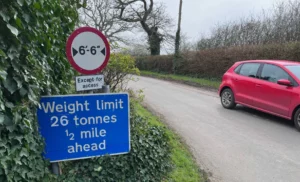Ten organisations have written to Housing Secretary Robert Jenrick urging changes to the Government’s proposed planning reforms to avoid adding a tide of car traffic to already overcrowded roads and undermining the Government’s wider social, economic and environmental goals.
This comed ahead of preparation for a Planning Bill to be announced in next week’s Queen’s Speech
Organisations including CPRE, RAC Foundation, Sustrans and the Transport Planning Society caution that new housing is being sited in places that cannot be served well by public transport, are inaccessible on foot or cycle and often have few or no local facilities. In addition, the design and layout of many developments inhibit walking, cycling and bus service provision; some developments even have no pavements. The Government’s proposed reforms to the planning system do not address this, and threaten to increase car dependence, air pollution and carbon emissions.
Jenny Raggett, coordinator of Transport for New Homes, which organised the letter, said: “At present, sustainable transport is all too often treated as an afterthought or even ignored when new housing is being considered. Our on-the-ground research shows that this results in estates where people have to drive everywhere, because they have no alternatives. Future lifestyles are then built around the car. The Government’s planning reforms are an opportunity to address this and create attractive places for people to live with good public transport and local facilities that people can walk or cycle to rather than soulless car-based estates.”
The letter calls upon the Government to focus its planning reforms on reducing car dependence, by:
- Revising the National Planning Policy Framework to give much more weight to developments around public transport and with good local services, and to discourage car-based developments.
- Revising the housing targets system so as to locate more development in urban areas and close to public transport.
- Bringing planning and transport closer together: integrating local plans with transport strategies.
- Making funding available, including through the Housing Infrastructure Fund, to support sustainable transport for housing rather than big new roads and junctions.
Steve Gooding, Director, RAC Foundation, said: “However ambitious the government’s targets are for the construction of new housing it will only ever be a fraction of the total housing stock year-by-year, but surely it is incumbent on us to ensure that whatever and wherever new housing is built it does not perpetuate the problems of the past? The worst – yet still avoidable – outcome would be to end up with cars parked in ways that obstruct walking, cycling and buses because the design of new developments has been poorly thought through, and for whose residents the alternatives to driving aren’t available because their location leaves them with poor connectivity to the services they need.”
Sarah Mitchell, Chief executive, Cycling UK, said:“Last year, the Government set out a bold vision to make cycling and walking the norm for day-to-day local journeys. Yet the planning system is still providing housing in remote car-dependent locations, with dangerous road and junction layouts, making it difficult for people to get by without a car. This must change if we are to tackle the crises of congestion, pollution, inactivity-related ill-health and the climate, while enabling children and other non-drivers to get around independently.”
Paul Tuohy, Chief Executive, Campaign for Better Transport, said: “Planning reforms must ensure that new developments do not lock in car-dependency. New housing should have basic amenities within easy walking distance and connectivity to employment, shopping and leisure by public transport, walking and cycling, creating healthier communities for generations to come.”
Crispin Truman, chief executive of CPRE, the countryside charity said: “Planning and transport should be two sides of the same coin. By ensuring all developments include low carbon public transport and active travel infrastructure that fit into people’s lives, we can begin creating healthy, carbon neutral communities. But right now our planning system is doing the opposite, producing dislocated, car dependent and land-hungry developments, especially in the countryside.
“These ill-conceived developments lock in car dependency and drive up carbon emissions that fuel runaway climate change. But there is a golden opportunity in the upcoming planning bill to change this approach and ensure all developments put public transport links, walking and cycling firmly ahead of road building. It’s high time the government steps up and locks in low carbon public transport for the nature friendly and healthy homes communities are calling for.”





















